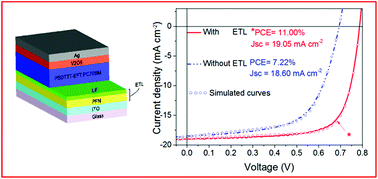High-efficiency organic solar cells based on a halide salt and polyfluorene polymer with a high alignment-level of the cathode selective contact†
Abstract
Advances in organic photovoltaic technology for improving the power conversion efficiency (PCE) towards the theoretical maximum require efficient light-absorbing polymers, a high alignment-level of selective contacts, and an easy manufacturing process with low cost to reach them. The halide salts constitute a highly promising class of materials that can produce better selective contacts in solar cells for improving the PCE. In this article, we demonstrate and report the use of a haloid salt in organic solar cells utilized as an interlayer. The haloid salt is deposited on top or below of polyfluorene polymer (PFN) layer and after it is placed on a transparent conductive oxide (TCO). Thermal evaporation of LiF layers is carried out to deposit ultrathin films of 0.5 nm to 0.8 nm thickness. As a photoactive layer we use the low-bandgap PBDTTT-EFT:PC70BM bulk-heterojunction. Among the different architectures analyzed we obtained a PCE of 11.00%, with an outstanding fill factor of FF = 73.5%, which is among the best reported for solar cells. This new stacking of a halide salt with polyfluorene materials could find use in fully exploiting the potential of various halide systems, and also opens up new opportunities to improve OSCs with a view to achieving record efficiencies.



 Please wait while we load your content...
Please wait while we load your content...